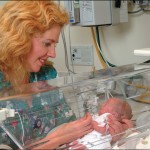Very low-birth-weight (VLBW) and very preterm (VPT) infants not born in highly specialized, level III hospitals have a higher risk of neonatal and pre-discharge death compared to similar infants born at level III hospitals, according to a recent Journal of the American Medical Association (JAMA) study.
Lead study author Sarah Lasswell, MPH, and colleagues at the Rollins School of Public Health conducted a large-scale analysis of previous research to examine the relationship between hospital level at birth and neonatal (generally the first four weeks after birth) or pre-discharge mortality for VLBW (weighing 53 ounces or less) and VPT (32 weeks or less gestation) infants to determine the importance of level of care at birth to survival.
 Lasswell and colleagues found that VLBW infants born in non-level III hospitals had a 62 percent increase in odds of neonatal/pre-discharge death compared with VLBW infants born in level III hospitals. In addition, VPT infants born in lower-level hospitals had a 55 percent increase in odds of neonatal/pre-discharge mortality compared with those born in level III facilities.
Lasswell and colleagues found that VLBW infants born in non-level III hospitals had a 62 percent increase in odds of neonatal/pre-discharge death compared with VLBW infants born in level III hospitals. In addition, VPT infants born in lower-level hospitals had a 55 percent increase in odds of neonatal/pre-discharge mortality compared with those born in level III facilities.
“The results of this review confirm a primary premise on which perinatal regionalization systems are based: high-risk infants have higher mortality rates when born outside hospitals with the most specialized levels of care,†Lasswell and colleagues write.
“Strengthening perinatal regionalization systems in states with high percentages of VLBW and VPT infants born outside of level III centers could potentially save thousands of infant lives every year.â€
About 13 million babies are born prematurely every year – nearly 10 percent of all newborns – and more than 1 million premature babies die each year, according to the March of Dimes.
The study, “Perinatal Regionalization for Very-Low-Birth-Weight and Very Preterm Infants: A Meta-Analysis,†was published in the Sept. 1, 2010, issue of JAMA. It was conducted as part of Lasswell’s graduate research at the Rollins School of Public Health under the direction of Roger Rochat, MD. Lasswell is now a researcher at the U.S. Centers for Disease Control.




